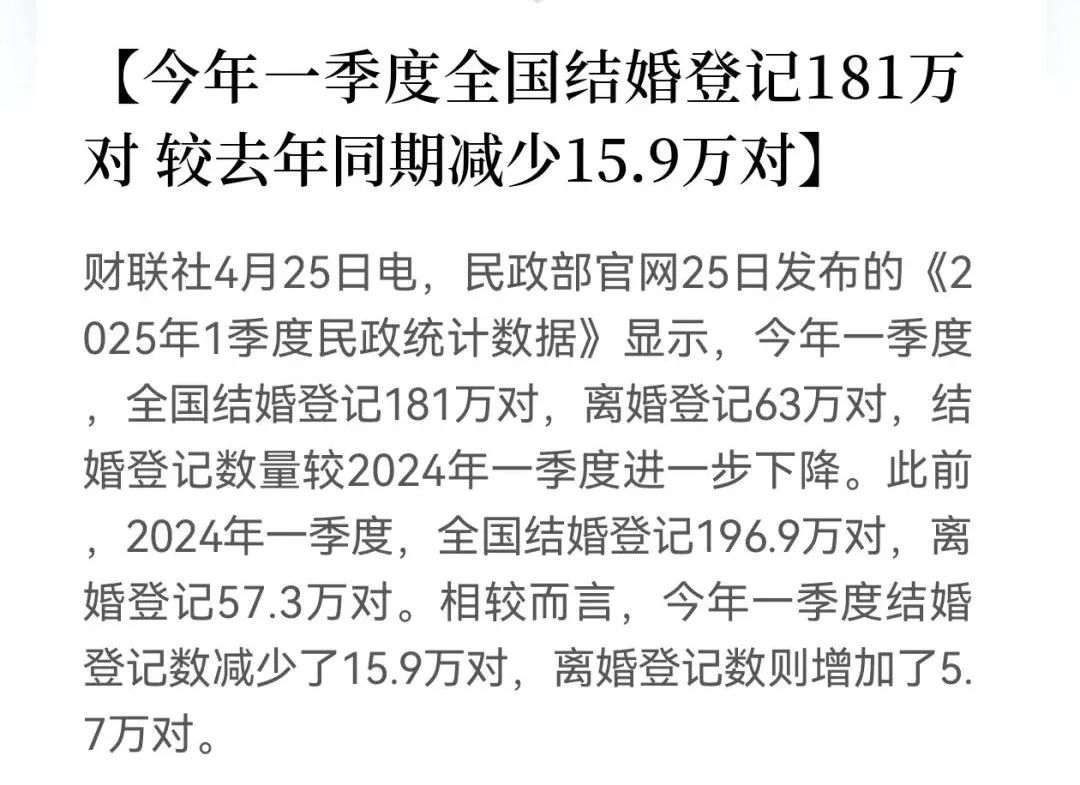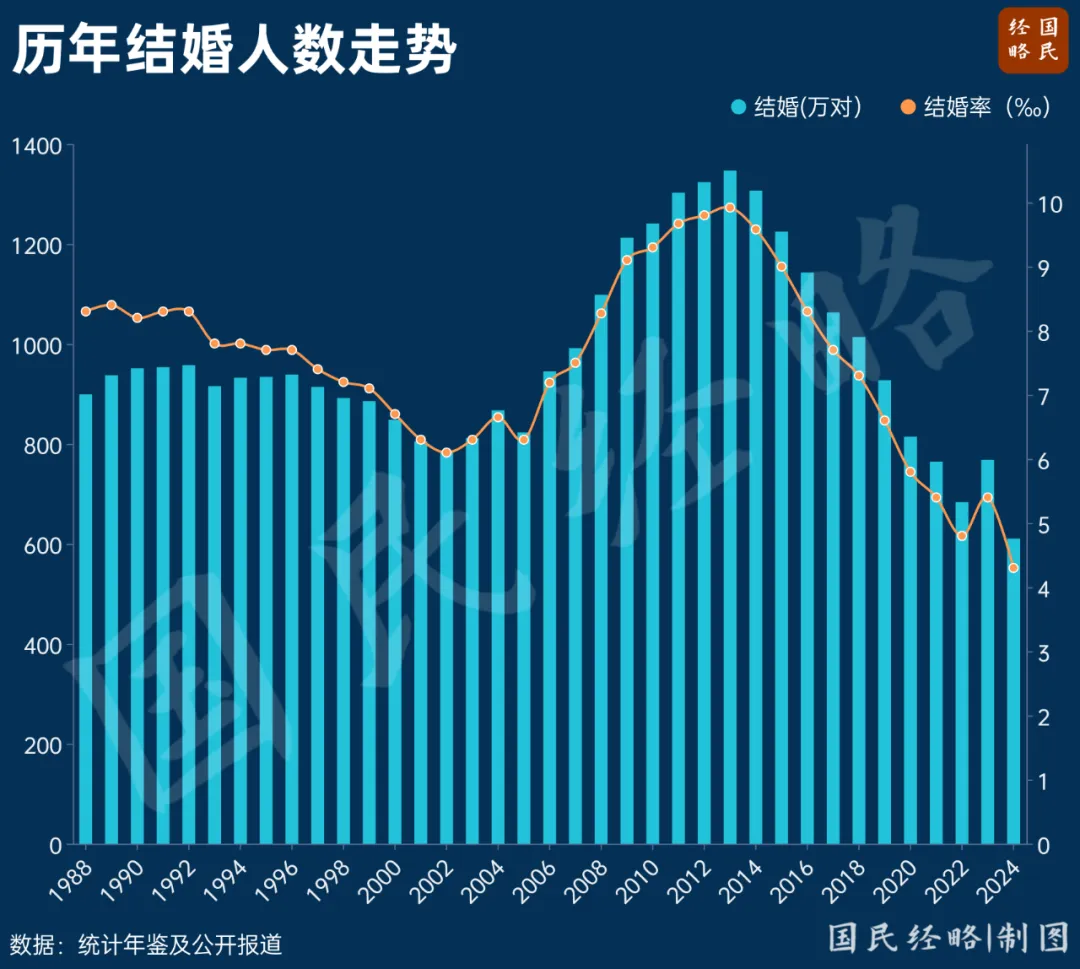html
1. Marriage Rates Hit Record Lows

Marriage, often regarded as a cornerstone of life, is witnessing a sharp decline in China. Government data reveals a stark drop in marriage registrations, raising alarms about the long-term impact on society, the economy, and population growth.
Key Statistics:
- In the first quarter of 2025, only 1.81 million couples registered to marry, a decline of 159,000 from 2024.
- In 2024, total marriages plummeted to 6.1 million, the lowest since 1980.
- Over the past decade, marriage rates have nearly halved from their peak.
Why Are Fewer People Marrying?
Initially, some attributed the 2024 decline to superstitions surrounding the “Year of the Dragon” as unlucky for weddings. However, the continued drop in 2025 underscores deeper issues:
- Changing priorities: Many young adults prioritize careers, personal freedom, or financial stability over marriage.
- High costs: Expenses like housing, weddings, and childcare make marriage feel unaffordable.
- Cultural shifts: Traditional views on marriage are weakening, especially among urban populations.
Why Does This Matter?
Marriage is intricately linked to birth rates and economic activity. Fewer marriages mean fewer families, potentially exacerbating China’s aging population crisis and reducing demand for housing, education, and consumer goods.
2. Zero Barriers to Marriage: A New Reality
To simplify the marriage process, China introduced significant reforms in May 2025 under the revised Marriage Registration Regulations.
Key Changes:
- Nationwide registration: Couples can now register in any city, regardless of residency.
- No household registration (hukou) required: A valid ID is now sufficient, eliminating the need for a household registration booklet that sometimes allowed families to block unions over disputes.
- Free registration: The 9 RMB ($1.25) marriage certificate fee has been abolished since 2017.
Why These Reforms?
- Modernization: In a mobile society, requiring couples to marry in their hometowns was outdated.
- Reducing conflicts: Removing the household booklet requirement prevents families from interfering in marriages.
- Preventing fraud: With national databases, authorities can easily verify marital statuses to stop bigamy or scams.
But Divorce Is Still Harder
While marrying is now easier, divorce retains hurdles like a mandatory 30-day “cooling-off period” introduced in 2021. Critics argue this traps people in unhappy marriages, but supporters believe it reduces impulsive splits.
3. Financial Incentives for Marriage

Lowering bureaucratic barriers isn’t enough. To tackle the root causes of low marriage rates, some local governments are offering cash rewards and subsidies.
Examples of Marriage Incentives:
- Zhejiang Province: Offers 1,000 RMB ($140) in cash or vouchers to couples where one partner is under 25 and a local resident.
- Shanxi Province: Provides 1,500 RMB ($210) to newlyweds if the wife is under 35.
- Guangzhou’s Nanzhao Village: Grants up to 40,000 RMB ($5,600) to couples who stay married for at least one year.
Limitations of These Policies:
- Most subsidies are small (1,000–2,000 RMB) and come with strict conditions (e.g., age, residency).
- They don’t address larger issues like housing costs, job stability, or cultural attitudes.
Why Subsidies?
Governments hope these incentives will:
- Offset wedding or housing expenses.
- Symbolically promote marriage as a social priority.
- Complement broader efforts to boost birth rates.
4. The Real Obstacles to Marriage

Financial incentives and simpler registration won’t reverse trends unless deeper challenges are addressed:
A. Soaring Costs of Marriage
- Housing: In cities like Beijing or Shanghai, apartments cost 10–20 times the average annual income.
- Dowries and weddings: Some families demand dowries exceeding 100,000 RMB ($14,000), while weddings alone can cost 50,000 RMB ($7,000).
- Childcare: Raising one child in China can cost 500,000 RMB ($70,000) by age 18.
B. Career vs. Family Pressures
- Long working hours and competitive job markets leave little time for dating or parenting.
- Women, in particular, face discrimination in hiring if employers suspect they’ll take maternity leave.
C. The Rise of Singlehood
Many young adults now view being single as a lifestyle choice, prioritizing travel, hobbies, or career growth over traditional milestones.
5. Why Governments Are Pushing Marriage
A. Marriage and Birth Rates Are Linked
Over 95% of births in China occur within marriages. With marriage rates falling, birth rates have also plummeted (China recorded 8.9 million births in 2023, down from 17.2 million in 2017).
B. Families Drive Economic Growth
Married couples are more likely to:
- Buy homes, cars, and household goods.
- Spend on childcare, education, and family activities.
- Contribute to long-term economic stability.
C. Avoiding a “Low-Desire Society”
Countries like Japan and South Korea show the risks of declining marriages:
- Japan’s “Lost Decades”: Low birth rates and weak consumer demand have stalled economic growth since the 1990s.
- South Korea’s “Three Giving-Up Generation”: Many young Koreans reject dating, marriage, and children due to financial stress.
6. The Road Ahead
Reversing marriage trends will require more than subsidies or policy tweaks. Potential solutions include:
- Affordable housing programs for newlyweds.
- Caps on dowries and wedding expenses.
- Flexible work policies to support work-life balance.
- Public campaigns to reduce stigma around singlehood or childless marriages.
Conclusion
China’s marriage crisis reflects deeper societal shifts—economic pressures, changing values, and the appeal of individualism. While new policies lower practical barriers to marriage, rebuilding young people’s confidence in the institution will take time. For now, the decline in marriages signals an urgent need for creative solutions to ensure long-term social and economic stability.
